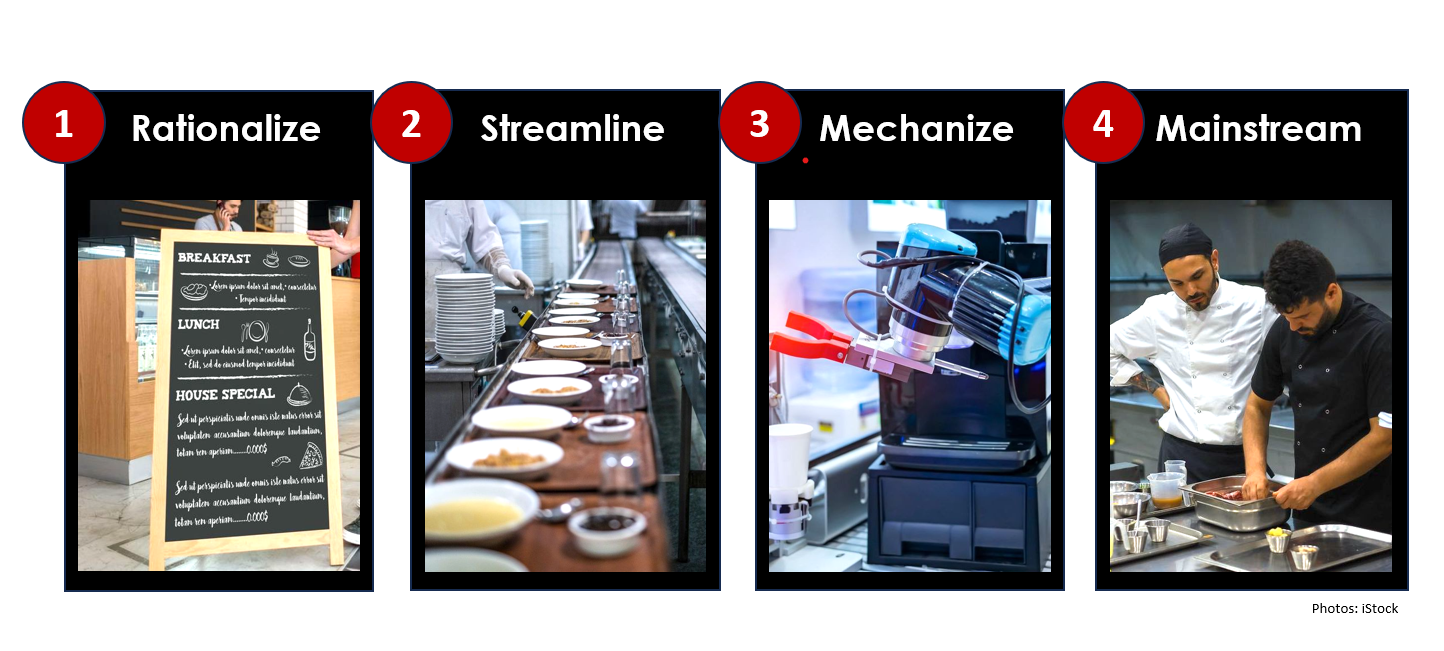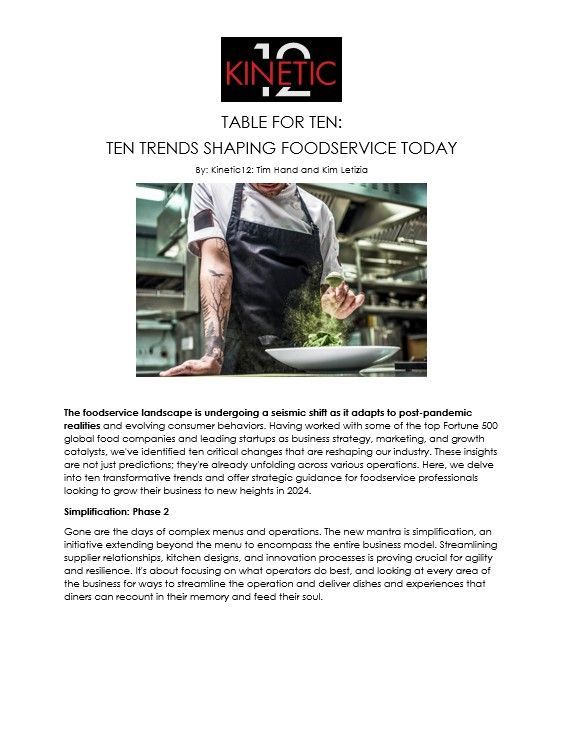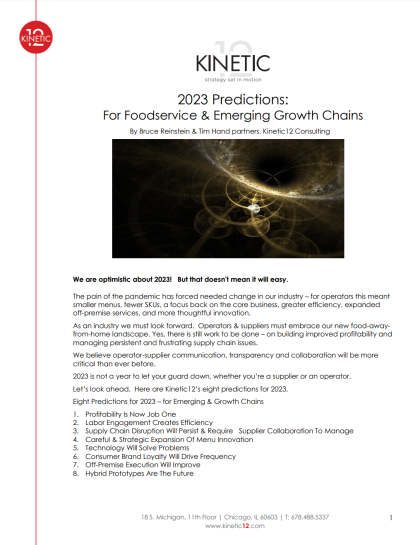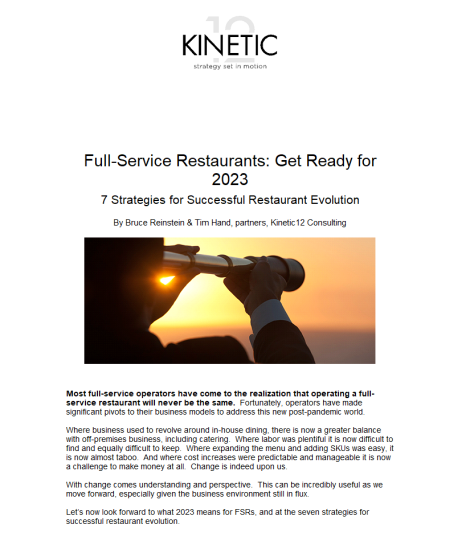The Power of Simplicity in Unlocking Chain Restaurant Growth
Iconic former Duke University basketball coach Mike Krzyzewski once said, “Growth creates complexity, which requires simplicity”.
Yet, simplicity is often overlooked as the first step towards achieving growth. In restaurants, that can include activities such as streamlining operations, reducing complexity and focusing on core strengths. Engaging in these simplification actions prior to pursuing a growth agenda can help restaurant operators increase efficiency, achieve better customer satisfaction and ultimately free up resources for business expansion. For suppliers, understanding where their chain account customers are streamlining and what that effort requires, is critical to providing support and to being a best-in-class partner.
Under the Kinetic12 Simplification Model, there are four levels of simplification activities: Rationalizing, Streamlining, Mechanizing and Mainstreaming. Each of these levels becomes more challenging for the operator to implement because they require additional resources, a greater time and financial commitment and seek to redefine ingrained ways of working.
Level 1: Rationalize
Stripping away the unnecessary allows you to focus on your core. To restaurant operators, this means:
- Simplifying the menu by limiting the number of menu items offered to focus on the most profitable and popular items
- Simplifying the preparation process by using fewer ingredients. The pantry should be evaluated with the aim of eliminating as many single-use items as possible, unless they allow you to cut short the preparation process
- Using seasonal and local ingredients

Kinetic12 Simplification Model, 2024
Operators started the menu and pantry rationalization process during the pandemic to save money and cut costs – it’s the first step most operators take to simplify their operations.
Level 2: Streamline
Next, re-engineer existing processes to make them more efficient. This includes:
- Investing in ready-to-use or speed scratch items rather than making them from scratch
- Rewriting recipes to take out non-essential steps and standardizing prep where possible
- Capitalizing on off-peak hours for food prep
- Reviewing and simplifying kitchen workflows
Streamlining focuses on taking existing processes and reconceiving of them to be easier and more efficient to execute.
Level 3: Mechanize
The third level of simplification is a form of streamlining processes but employs automation to make processes more efficient and take human labor out of the process. Examples include:
- Using inventory management software to track stock levels, ordering only what is needed
- Investing in POS systems that help more accurately forecast demand
- Implement automated order taking to reduce labor costs and errors
- Adding robots to the back of house to complete repetitive tasks (stirring, mixing, cleaning, etc.)
Mechanizing your operation allows you to redeploy your valuable human capital to focus on value-added customer-facing activities and look to machines, systems or apps to handle the non-value-added activities in your operation.
Level 4: Mainstream
Once you’ve streamlined and mechanized your processes, investing in staff training and communications is essential. It is particularly important in today’s high-turnover labor market to cross-train staff to perform multiple roles. Unclear job responsibilities and processes lead to inefficiencies, lost productivity and job frustration, which translates into higher costs for the operator. According to Kinetic12’s Emergence Survey, training and development is seen by over half of operators as a high priority activity meant to improve a restaurant’s culture and ultimately improve employee satisfaction, which plays a role in reducing staff turnover rates and managing labor costs.
How Suppliers Can Help
Food and equipment manufacturers can play a crucial role in helping restaurants simplify their operations and menus by offering tailored products, support services and innovative product solutions to operators, including:
- Pre-portioned ingredients to ensure consistency and reduce prep time
- Ready-to-use components such as sauces, bases and marinades to simplify the cooking process
- Versatile products that can be used across different dishes and across multiple menu-parts and dayparts to streamline the pantry
- Collaboration on recipe development that uses their products most effectively
- Detailed nutritional information to help restaurants meet dietary requirements and regulatory standards
- Online tutorials and resources for staff training on new products, services and techniques
- Data analytics that provide insight on product usage and sales trends, aiding decision-making
- Waste reduction programs to minimize food waste, such as compostable products or food donation programs
Growth through simplification involves a relentless focus on core competencies, operational efficiencies, customer experience and streamlined processes. By simplifying - reducing complexity and focusing on what truly adds value - restaurants can achieve sustainable growth and profitability and enhance long-term customer satisfaction.
Jennifer Brizzolara is a partner at Kinetic12 Consulting, a Chicago-based Foodservice and general management consulting firm. The firm guides multiple best practice projects and forums, and consults with leading Foodservice suppliers, operators, PE firms and associations on strategic initiatives. Her previous leadership roles at Foodservice manufacturers provides a valuable perspective and insight into how the industry is evolving and what must be done to stay relevant.



